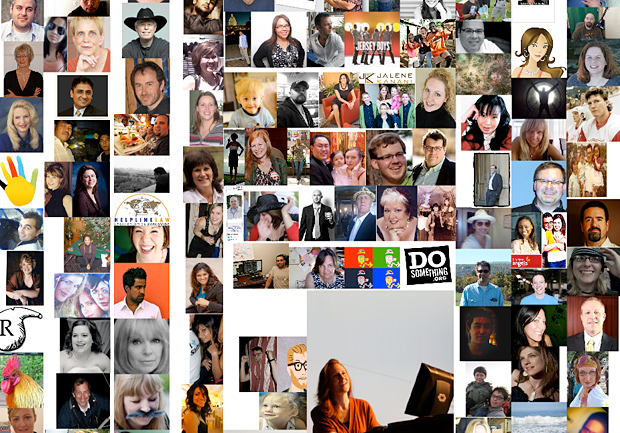 Gen-Y’s are today’s face of entrepreneurship. When an idea strikes they bring a level of energy and innovation that is simply unmatched.
Gen-Y’s are today’s face of entrepreneurship. When an idea strikes they bring a level of energy and innovation that is simply unmatched.
In the past it was experience that gave entrepreneurs the ability to predict the next big thing. Now, passion and innovative thinking are the key drivers behind today’s successful entrepreneurs and tomorrow’s most prolific business leaders.
Before I started Redwood Strategic, I saw how companies constantly struggled to effectively build relationships between brands and students. I was passionate about using new media, marketing and the digital world to help them find a solution, and this eventually formed the basis of my company.
innovation DAILY
Here we highlight selected innovation related articles from around the world on a daily basis. These articles related to innovation and funding for innovative companies, and best practices for innovation based economic development.
Entrepreneurship Education for All
 In the late 1970s, about 500 colleges and universities offered courses in entrepreneurship. By 2005, more than 2,000 did so. Yet there has been no corresponding surge in start-up activity. "The things we've been trying on campuses have had a marginal impact, if that," says Dane Stangler, a researcher at the Kauffman Foundation. To be sure, there are individual programs that have a proven record of generating real companies. What they generally have in common is a belief that entrepreneurship training is for everyone -- not just M.B.A.'s, but engineers and art students, too.
In the late 1970s, about 500 colleges and universities offered courses in entrepreneurship. By 2005, more than 2,000 did so. Yet there has been no corresponding surge in start-up activity. "The things we've been trying on campuses have had a marginal impact, if that," says Dane Stangler, a researcher at the Kauffman Foundation. To be sure, there are individual programs that have a proven record of generating real companies. What they generally have in common is a belief that entrepreneurship training is for everyone -- not just M.B.A.'s, but engineers and art students, too.
A good case in point is MIT. The school's students and alumni start 200 to 400 businesses a year. One of the keys to that success is the school's Entrepreneurship Center. Launched in 1991, the center serves the university's five schools, acting as the nexus for entrepreneurship classes, clubs, and activities; connecting business students with scientists; and providing physical space, advice, and access to a network of entrepreneurs and investors -- all with the goal of creating new ventures. "We're the DMZ where the geeks can meet the suits and make companies," says the center's managing director, Bill Aulet.
From America to Canada to Starbucks
 “America Needs to Make Its Bad Jobs Better” in The Financial Times.
“America Needs to Make Its Bad Jobs Better” in The Financial Times.A growing chorus of commentators believes America faces an increasingly jobless future. They argue that the US economy can no longer create meaningful numbers of high-paying jobs, especially for less skilled workers who lack college or more advanced degrees.
There is no question that millions of high-paying jobs have been eliminated and private sector job creation has been anaemic. The US unemployment level did fall to 9.5 per cent in the latest figures released on Friday, but this decrease was mostly because more than half a million people gave up looking for work at all.
Periods of crisis and creative destruction such as the current one are when new categories of jobs are created as old categories of jobs are destroyed. The key to a sustained recovery is to turn as many of these – as well as existing lower-paying jobs – into better, family-supporting jobs.
“Why Canada Needs a Great Reset” in Ottawa Citizen.
With the G8 and G20 summits behind us, most Canadians now realize how comparatively unscathed we’ve come through the great economic crisis. But we shouldn’t be too hasty to pat ourselves on the back. Our economy is badly in need of significant structural changes. Without the pressure of a crisis, there’s a real danger that we’ll settle for complacency, instead…
Thanks to Canada’s risk-averse system of financial regulation, its banks are model citizens, admired around the globe; Canada’s housing markets swiftly rebounded and are already booming again. Though Canada’s gross domestic product declined just as precipitously as the U.S.’s did, we got off lightly when it came to unemployment. Some of Canada’s laid-off auto workers are being called back to work at formerly quiet factories from Windsor to Oshawa, and companies from Research in Motion to Loblaw are hiring new workers to support their growth.
Read the full piece here (PDF).
From idea to initiative
500 young Jewish innovators brainstorm for the community’s future.
What
happens when 500 leading Jewish innovators come from all over world to
think up creative solutions to the challenges that face the Jewish
people?
On Wednesday at Hotel Kfar Maccabiah, participants in
the ROI Global Summit for Young Jewish Innovators embarked on an
ambitious two-day journey to do just that.
At its annual
leadership conference, ROI hosted their first-ever “Community Brainstorm
& Action Planning” experiment with the goal of generating potential
project ideas and then putting them into action.
ROI, funded by
philanthropist Lynn Schusterman, is committed to helping prepare the
Jewish community’s young leaders to take the reins from their elders.
Imagine Cup Challenges Students to Solve World Problems with Technology

“We deeply believe that tomorrow’s innovators will come from the dorm room, not the boardroom.”
That is a quote from Microsoft’s general manager of Education Strategy, Jon Perera. For eight years now, Microsoft has sponsored the worldwide Imagine Cup, a technology competition for high school and college students around the world. This year’s theme is, “Imagine a world where technology helps solve the world’s toughest problems.” Students work in teams to compete in a number of broad categories including software design, embedded development, game design, digital media and IT challenge, which is a systems level survey for managing technology.
This year’s event is being held in Warsaw, Poland home of the astronomer Nicolas Copernicus and physicist Marie Curie-Sklodowska. Opening ceremonies on July 3rd kicked off the competition of projects of teams who have advanced to the worldwide finals. Consisting of several students and a mentor to provide guidance, each team has advanced through several regional events in their respective countries to qualify to appear in Warsaw. For them, this is a once in a lifetime opportunity to demonstrate the application of their ideas – ideas that can help change the world.
The Social Innovation Fund One Year Later
 One year ago, President Obama officially announced the upcoming
launch of a Social Innovation Fund (SIF) that would call on
“foundations, philanthropists, and others in the private sector to
partner with the government to find and invest in innovative,
high-impact solutions.” He went on, “Now more than ever, we need to
build cross-sector partnerships to transform our schools, improve the
health of Americans, and employ more people in clean energy and other
emerging industries. These community solutions will help build the new
foundation for the economy and the nation.” For more in depth
information about this White House announcement read our blog
post.
One year ago, President Obama officially announced the upcoming
launch of a Social Innovation Fund (SIF) that would call on
“foundations, philanthropists, and others in the private sector to
partner with the government to find and invest in innovative,
high-impact solutions.” He went on, “Now more than ever, we need to
build cross-sector partnerships to transform our schools, improve the
health of Americans, and employ more people in clean energy and other
emerging industries. These community solutions will help build the new
foundation for the economy and the nation.” For more in depth
information about this White House announcement read our blog
post.
To commemorate this anniversary and in anticipation of the announcement this month of the intermediary organizations that will receive grants from the Corporation for National & Community Service, we have culled through the discussions that have taken place about the Fund over the past year – some congratulating strengths and others pointing out shortcomings or sounding a note of caution. The following viewpoints are a compilation of Nell Edgington, Pablo Eisenberg, Carla Javits, Jasmine McGinnis, Adin Miller, Sean Stannard-Stockton, and Andrew Wolk.
One Of The Signs The NYC Startup Boom Is Here To Stay: The First Growth Venture Network
 One reason to think that the surge in startup activity in New York City
over the past few years isn't just a bubble is that the rise in startup
and VC activity has been accompanied by the creation of a robust support
network for entrepreneurs.
One reason to think that the surge in startup activity in New York City
over the past few years isn't just a bubble is that the rise in startup
and VC activity has been accompanied by the creation of a robust support
network for entrepreneurs.
Startups have a level of access to talent, fellow entrepreneurs, VCs, and angels that is old hat in the Valley, but that wasn't possible in New York during the dotcom bubble.
One recent example: the First Growth Venture Network. Founded by angel investor and venture capital professor Ed Zimmerman, First Growth is a mentoring program for early-stage startups. Accepted entrepreneurs attend a series of talks and roundtables, are paired with mentors from more established startups, and are introduced to advisors and investors from all over the country.
Introducing The Tales Of Micro-Multinationals
 This is the era of tiny companies that operate globally. These micro versions of multinationals outsource almost everything to specialists all over the world and sell to people all over the world through the Internet.
This is the era of tiny companies that operate globally. These micro versions of multinationals outsource almost everything to specialists all over the world and sell to people all over the world through the Internet.
In olden days, “multinational” meant big. And it took a long time to get there. You started locally, then you expanded within a local region, then you went national and finally you went multinational. Now we see companies going global from day one, enabled by the Internet.
We will chronicle the real stories behind this transformation in business. We are interviewing the founders and managers of these micro-multinationals to find out what it is really like to manage a business at the leading edge of this trend.
Becoming a Successful Principal Investigator
 It is not enough to have a good idea. Your good idea must also be well positioned, or review panels for grant agencies are unlikely to approve it. A year ago, I wrote a column about how to best position your research idea to attract a grant. Now I'd like to turn the focus on you, the investigator.
It is not enough to have a good idea. Your good idea must also be well positioned, or review panels for grant agencies are unlikely to approve it. A year ago, I wrote a column about how to best position your research idea to attract a grant. Now I'd like to turn the focus on you, the investigator.
Grant writing is the end of a process, not the beginning. Long before you make the decision to write a grant proposal for your research, you should be taking concrete steps to raise your profile in the eyes of reviewers.
What does that mean? Most basically, it means preparing yourself as a scholar, a researcher, and a grant writer in ways that will strengthen the ideas behind your proposal, demonstrate that you have the wherewithal to carry out your project, and enhance your ability to communicate what reviewers are looking for.
Nine Smart Grid Trends of 2010
 Upgrading our nation’s electricity infrastructure has the potential to reduce costly capital investments (costs that get passed on to us) and increase energy efficiency (more bang for your buck is always appreciated!).
Upgrading our nation’s electricity infrastructure has the potential to reduce costly capital investments (costs that get passed on to us) and increase energy efficiency (more bang for your buck is always appreciated!).
As technology advances and environmental issues rotate into the spotlight of 24 / 7 news coverage and dinner table conversations, smart grid solutions will continue to have a growing impact on our lives. This is especially true as the U.S. Energy Information Administration estimates that the demand for electricity will increase 30 percent from 2008 to 2035 – or about 1 percent a year.
White House Seeks Nanotechnology Ideas
The OSTP has released a Request for Information (RFI) for ideas on the
development of the 2010 Strategic Plan for its National Nanotechnology
Initiative (NNI), a 25-agency R&D program, according to a White
House blog post by OSTP Policy Analyst Heather Evans and OSTP
Assistant Director for Nanotechnology Travis Earles.
 The Office of Science and Technology Policy wants
input on its plan to explore how the government can spur a revolution
in the use of nanotechnology.
The Office of Science and Technology Policy wants
input on its plan to explore how the government can spur a revolution
in the use of nanotechnology.
European Innovation Partnerships
 One such idea is the European Innovation Partnership (EIP). This is conceived as a new approach to involving all member states in linking up the innovation chain to get products through to market faster. The EIP is being fleshed out as part of the Europe 2020 strategy, the Commission’s plan for innovation-led industrial growth and economic revival.
One such idea is the European Innovation Partnership (EIP). This is conceived as a new approach to involving all member states in linking up the innovation chain to get products through to market faster. The EIP is being fleshed out as part of the Europe 2020 strategy, the Commission’s plan for innovation-led industrial growth and economic revival.
Detractors say the EIP, with its vision of partnerships between the EU and member states, plugging basic research directly to innovation to short-circuit the development of technologies, make breakthroughs and get the results into the marketplace, is little more than a new name for an old idea. The Commission begs to differ, insisting the political environment has changed and that such partnerships have the potential to unleash benefits for the economy and society.
On extra effort...
 Get the 212 card Get the 212 card | |
|
Arthur Rock on Venture-Capital Carried Interest
 In a recent interview, venture-capital pioneer Arthur
Rock discussed his early days in the venture-capital industry and
why he’s now investing in corporate governance and education issues. He
also waded into a contentious debate about venture-capital carried
interest.
In a recent interview, venture-capital pioneer Arthur
Rock discussed his early days in the venture-capital industry and
why he’s now investing in corporate governance and education issues. He
also waded into a contentious debate about venture-capital carried
interest.
Carried interest is the profits that venture capitalists make on
their start-up investments. For years, such profits have been taxed at
the rate of capital gains taxes, which are currently at 15%. But there’s
been a move afoot by legislators to tax carried interest at the rate of
ordinary income taxes, which can go as high as nearly 40%.
The National Venture Capital Association and many venture capitalists from firms such as Scale Venture Partners and Kleiner Perkins Caufield & Byers have opposed the potential change, which is currently awaiting a legislative vote in Washington D.C. The NVCA says it’s possible that a higher tax rate could hurt the risk-taking among venture capitalists, among other things.
Big Companies Offer Carrots to Start-Ups
 The auto industry is moving forward. Just look at the successful
public listing last week of the electric carmaker Tesla Motors,
Breakingviews says.
The auto industry is moving forward. Just look at the successful
public listing last week of the electric carmaker Tesla Motors,
Breakingviews says.
General Motors wants to innovate, too. It’s plowing $100 million into a venture capital fund to create new technologies and add to the bottom line. Corporate venture capital can be a creative way to outsource research and development. But the odds of spawning anything more look long.
Like other big companies, G.M. has carrots to entice start-ups. It can offer quick access to potential markets in everything from batteries to entertainment systems. And it has already invested in equipment like wind tunnels, which may be a nice perk for some new thinkers.
Popularity, Ego, and Influence - What Is the Influence Project?

In roughly 24 hours, nearly 6,000 people have registered to participate in an experiment we started called The Influence Project. It's been written about by TechCrunch, The Huffington Post, The New York Times, and a score of personal blogs. While it hasn’t taken off the way as quickly as the David After Dentist or Yosemitebear Mountain Giant Rainbow videos, it's off to a good enough start to bust our servers (briefly). But like anything that gains traction on the Web, the reactions have been mixed, ranging from the vitriolic to the pretty damn amusing.
One side effect of instant popularity is that most people are unaware of the evolution of this idea, and how the thing actually works. The Influence Project is a byproduct of a story I wrote in the May issue of Fast Company about the ad and marketing shop Mekanism. Mekanism told me they could make just about anything go viral. So I asked them to create a viral marketing campaign for Fast Company (they were not paid for this, but did it because it sounded like fun). In return, I would document the process and see if they could deliver. Mekanism came back with pitches ranging from a Twittering Business Jesus who responds to prayers from companies in distress, to a jingoistic campaign titled Fuck China (we passed on both, but you can still see the full brief). Instead, we settled on an idea called The Cover Project—so named because everyone who participates would get their photo in a story that might hit the cover of a fall Fast Company issue. We’ve changed the name since then, because the editorial story I wanted to pursue, the story that is constantly evolving and morphing, is the story of influence and influencers and how they are employed to both spread or kill ideas on the Internet. And voila—The Influence Project.
Small Business Has Role in Bridging 'Valley of Death'
 Promising drugs that could save lives face a “Valley of Death” when moving from basic research to clinical study and into the marketplace. That was the message and the focus of a national town hall held in Kansas City on Tuesday.
Promising drugs that could save lives face a “Valley of Death” when moving from basic research to clinical study and into the marketplace. That was the message and the focus of a national town hall held in Kansas City on Tuesday.
The New Role of Academia in Drug Discovery and Development Town Hall brought together an elite group of senior government officials and leading experts representing industry, academia, venture capital, technology centers and venture philanthropy. Speakers included Kathleen Sebelius, secretary of Health and Human Services; Francis Collins, director of the National Institutes of Health; Margaret Hamburg, commissioner for the Food and Drug Administration; and former House Majority Leader Richard Gephardt, now chairman of the Council for American Medical Innovation.
Sebelius told attendees that the future of the country and the region is tied to the success of bioscience. “We are at a pivotal moment in bioscience research in America,” Sebelius said.
She lauded the dedication to bioscience “seen here in the Heartland,” and said we can’t have a healthier country without a focus on long-term investment and a national commitment to science.
U2 VC: $120M to FB
 It's a beautiful day at Facebook.
Elevation partners has just injected
$120 million in venture capital, which will certainly help power-up
Zuckerberg's business ... but why did Bono's firm make this move?
It's a beautiful day at Facebook.
Elevation partners has just injected
$120 million in venture capital, which will certainly help power-up
Zuckerberg's business ... but why did Bono's firm make this move?
Back in November 2009 Elevation slid about $90 million over the negotiation table in exchange for 2.5 million shares in the world's most popular social networking Web site, and has seen that investment multiply by two and a half times in value. So perhaps it's not surprising that Elevation has just forked over another $120 million for a further five million shares at the moment--especially given the fact that the economy really seems to be recovering, and Facebook's success has been continuing onwards and upwards with more users joining every day. Who wouldn't want a big piece of one of the hottest Net properties in one of the hottest new Web-tech trends, social networking? And with your investment more than doubling in just eight months, Elevation's hope has to be that its $210 million will quickly turn into $1 billion. TechCrunch also notes that two of Elevation's founders--Bono and Roger MacNamee--already were personal investors in the social net, which may have added some extra sizzle to the business deals.
MSU Throwing in the Towel in Dubai

 When Michigan State University announced plans to expand into Dubai in 2007,
President Lou Anna K. Simon described the move as "transformational for a
university with an expanding 'world-grant' mission" (get it? --
"world-grant," not "land-grant"). She added that "other U.S.
institutions are likely to follow MSU’s path."
When Michigan State University announced plans to expand into Dubai in 2007,
President Lou Anna K. Simon described the move as "transformational for a
university with an expanding 'world-grant' mission" (get it? --
"world-grant," not "land-grant"). She added that "other U.S.
institutions are likely to follow MSU’s path."
Any followers would do well to learn from Michigan State’s combination of ambition, mistakes and misfortune. After just two years of operation, MSU Dubai has moved to immediately discontinue its undergraduate programs due to under-enrollment. That just 85 students are affected is testament to the extent of the institution’s struggle.
"This work that we tried to do, in which essentially students who were studying in Dubai had the same admissions standards, curriculum and course expectations as if they were in East Lansing, proved to be more difficult to pull off than we had imagined," Simon said in an interview Tuesday. "Part of that you can blame on the economic circumstances" -- MSU Dubai opened its doors in fall 2008 as a global recession closed in -- "part of it, you can look at ways in which the experiment began and some of the underlying assumptions."
Five Types of Innovation Snake Oil Consultants
 You’ve probably come across many self-claimed innovation experts in the past and it seems like anyone who has a different way of saying or doing something is calling themselves one. So many dumb things I’ve heard these people said about innovation. Some are snake oil consultants promising to help clients to innovate and to organize a company for innovation. There are some selling to clients how to be creative I’ve heard people promising clients that they can improve innovation success rate from 4% to 80%! 80% wow, if that’s the case, this consultancy should worth a few billions at least. Google would have bought them already!
You’ve probably come across many self-claimed innovation experts in the past and it seems like anyone who has a different way of saying or doing something is calling themselves one. So many dumb things I’ve heard these people said about innovation. Some are snake oil consultants promising to help clients to innovate and to organize a company for innovation. There are some selling to clients how to be creative I’ve heard people promising clients that they can improve innovation success rate from 4% to 80%! 80% wow, if that’s the case, this consultancy should worth a few billions at least. Google would have bought them already!
And then there’s talk about what type of people are best suited to be innovators. What kinds of archetype that represent the best quality of an innovator. This is so BS, innovators come in all sizes and shapes. I’ve come across many big ideas people who were trained in finance, economics, accountancy, legal, operations and engineering… and I’ve also met many working in the creative industries with zero ability to come up with big (medium or small) ideas although they dress creatively (that’s a matter of taste).


